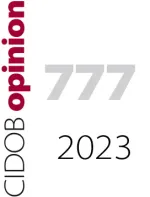Migration Agreement?

The twenty-seven countries of the European Union have unlocked an agreement on the Pact on Migration and Asylum. The process of negotiation among the EU institutions will now begin and it remains to be seen, if it is approved, how this precarious balance might materialise in practice when the interests concerned do not only diverge but are also clearly inflamed by the politicisation of immigration in their respective national contexts.
This article was previously published in the newspaperARA.
Since 2015, Europe has been haunted by the possibility of a new migration crisis. Then, Angela Merkel uttered the famous words, “Yes we can”, in response to the question of whether Europe could take in refugees. But immediately afterwards, Europe said, “Enough”. Ever since, it has been obsessed with making sure this does not happen again. The Bulgarian political scientist, Ivan Krastev, calls it the European 9/11. Despite this fear, the EU has taken eight years to conclude a new migration pact. The aim is twofold: to seal European borders, and a more equitable distribution of responsibility among the Member States. But is there really agreement?
Most of all, there is hurry. At the European level, there is no desire to be faced with the European elections in June 2024 without having shown unity and determination with regard to the question of migration. Not achieving this would give wings to Eurosceptic and far-right discourse about the inability of European governments to respond to the situation. Moreover, nobody wants in the rotating European Presidency countries like Hungary and Poland, which directly contest the need for an agreement. At the national level, in a situation of growing numbers of arrivals and requests for asylum, governments like those of Germany and Italy urgently need to calm internal tensions. In the case of Germany, the spectre of the far right looms again.
There is a rush but there is also some agreement, especially on certain matters. The Vice-President of the European Commission, Margaritis Schinas, describes the Pact as being like a three-storey house where one floor is concerned with relations with third countries, a second with management of external borders, and a third with distributing responsibility among member states. Agreement exists mainly between the first two floors. The third continues to be home to hubbub. In the case of the first floor, there is agreement that third countries are essential for helping to contain illegal arrivals. No one doubts this. The problem lies with the consequences since depending on them leaves European countries in their hands, and there is no regime that willingly accepts the forced return of its citizens. In addition, agreements with governments like that of Tunisia still arouse certain suspicions and do not always end well.
On the second floor, that of the border, the Pact allows delays in registration of asylum seekers, introduction of second-rate border asylum procedures, and expanded time of border detention. In short, it means lower standards, and legalising what, hitherto, was unequivocally illegal. The Crisis Regulation, the last that was left to be approved, only aggravates matters. The result is a creation of liminal and exceptional spaces, liminal because the question of whether a border has been crossed is in doubt, and exceptional because, in this no-man’s land, certain laws (and hence, rights) no longer apply. This was one of the demands made by Meloni. Meanwhile, the delays and concentration of procedures at borders only consolidates the role of Greece, Italy, and Spain as the chief guardians of Europe’s southern borders.
Finally, the third floor still requires caution. To begin with, the Pact has forsaken its original intention of a fairer distribution of asylum seekers among the Member States. There will be no mandatory refugee relocation quotas. Solidarity has now become a matter of fines, the notorious 20,000 euros per asylum seeker for countries that refuse to take them in. Although this is a minimum agreement, Poland and Hungary have already said they consider it to be unacceptable. Then again, the Dublin Regulation—the one that Angela Merkel said in 2015 was not working—remains in force and even strengthened. For example, the period during which an asylum seeker who has entered through Spain can be returned from Germany has doubled from twelve to twenty-four months. Once again, the burden is on the countries of first entry. As long as the unequal distribution continues, the system will remain dysfunctional.
Is there an agreement then? It depends on how the negotiations with the European Parliament will proceed and, if the Pact is approved, how this precarious balance might materialise in practice when the wishes concerned not only diverge but are also clearly inflamed by the politicisation of immigration in their respective national contexts. However, we could say that, yes, there is agreement, at least outwardly. This is how it has been presented by the Spanish government, which is proud that it has happened under its Presidency of the Council of the European Union. Nevertheless, once again, words and facts differ. The headlines show agreement, but the gestures point in a different direction. Granada was the setting. While Sunak and Meloni called a meeting of six (United Kingdom, Italy, France, the Netherlands, Albania, and the European Commission) to discuss “other” measures for stopping the illegal arrivals, Orbán arrived in the city declaring the Hungary and Poland had been “legally violated” by the Pact.
Keywords: Pact on Migration and Asylum, EU, Italy, Hungary, Poland, Spanish presidency, border, arrivals, European Parliament, 2024 elections